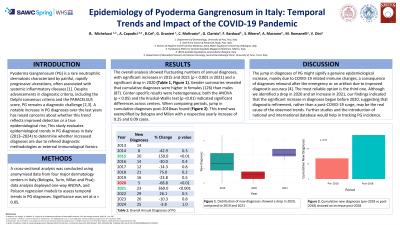Clinical Research
(CR-049) Epidemiology of Pyoderma Gangrenosum in Italy: Temporal Trends and Impact of the COVID-19 Pandemic
Saturday, May 3, 2025
2:10 PM - 3:10 PM East Coast USA Time

Bianca Cei, MD – Department of Dermatology – University of Pisa, Pisa, Italy; Giammarco Granieri, MD – Department of Dermatology – University of Pisa, Pisa, Italy; Chiara Moltrasio, MD, PhD – Dermatology Unit , Fondazione IRCCS Ca’ Granda Ospedale Maggiore Policlinico, Milan , Italy; Giacomo Clarizio, MD – Department of Dermatology – Policlinico Sant'Orsola, Bologna, Italy; Simone Ribero, MD, PhD – Dermatology Clinic Department of Medical Sciences – University of Turin, Turin, Italia.; Federico Bardazzi, MD – Department of Dermatology – Policlinico Sant'Orsola, Bologna, Italy; Angelo Marzano, MD, PhD – 1) Dermatology Unit , Fondazione IRCCS Ca’ Granda Ospedale Maggiore Policlinico, Milan , Italy 2) Department of Pathophysiology and Transplantation , Università degli Studi di Milano , Milan , Italy; Valentina Dini, MD, PhD – Department of Dermatology – University of Pisa, Pisa, Italy; Marco Romanelli, MD, PhD – Department of Dermatology – University of Pisa, Pisa, Italy
Introduction: Pyoderma gangrenosum (PG) is a rare, ulcerative neutrophilic dermatosis that has shown fluctuating incidence over time [1]. This study analyzes the epidemiology of PG in Italy from 2009 to 2024, with particular attention to trends in new diagnoses and the potential impact of the COVID-19 pandemic.
Methods: Data were collected from four Italian centers (Pisa, Milan, Bologna, and Turin) and included total annual diagnoses, gender distribution, and patient age. The analysis highlights temporal trends, comparing pre-pandemic (2009-2019), pandemic (2020-2022), and post-pandemic (2023-2024) periods.
Results: Between 2009 and 2024, PG cases exhibited an overall increasing trend, particularly after 2013. In 2020, there was a noticeable decrease in PG diagnoses across all centers, reflecting the challenges posed by the COVID-19 pandemic. However, diagnoses were still reported (Pisa: 0 cases; Milan: 2 cases; Bologna: 2 cases; Turin: 1 case), indicating some level of continued healthcare access. Diagnoses increased further in 2021 (Pisa: 5 cases; Milan: 9 cases; Bologna: 5 cases; Turin: 4 cases), with a sharp rise observed in 2022 (total: 29 cases), surpassing pre-pandemic levels. Gender distribution remained consistent, with a predominance of female patients. The mean age of diagnosis varied slightly among centers but showed no significant shift across the study period.
Discussion: PG diagnoses have increased significantly since 2021, possibly due to resumed post-pandemic activities or an actual rise in disease occurrence [2]. The testing of vilobelimab (IFX-1), a complement C5a inhibitor, for both COVID-19 and PG suggests shared immunological pathways involving neutrophilic activity and complement system activation [3]. Connections between COVID-19 and PG exacerbation underscore the need to monitor individuals with neutrophilic dermatoses during and after COVID-19 infection or vaccination
Methods: Data were collected from four Italian centers (Pisa, Milan, Bologna, and Turin) and included total annual diagnoses, gender distribution, and patient age. The analysis highlights temporal trends, comparing pre-pandemic (2009-2019), pandemic (2020-2022), and post-pandemic (2023-2024) periods.
Results: Between 2009 and 2024, PG cases exhibited an overall increasing trend, particularly after 2013. In 2020, there was a noticeable decrease in PG diagnoses across all centers, reflecting the challenges posed by the COVID-19 pandemic. However, diagnoses were still reported (Pisa: 0 cases; Milan: 2 cases; Bologna: 2 cases; Turin: 1 case), indicating some level of continued healthcare access. Diagnoses increased further in 2021 (Pisa: 5 cases; Milan: 9 cases; Bologna: 5 cases; Turin: 4 cases), with a sharp rise observed in 2022 (total: 29 cases), surpassing pre-pandemic levels. Gender distribution remained consistent, with a predominance of female patients. The mean age of diagnosis varied slightly among centers but showed no significant shift across the study period.
Discussion: PG diagnoses have increased significantly since 2021, possibly due to resumed post-pandemic activities or an actual rise in disease occurrence [2]. The testing of vilobelimab (IFX-1), a complement C5a inhibitor, for both COVID-19 and PG suggests shared immunological pathways involving neutrophilic activity and complement system activation [3]. Connections between COVID-19 and PG exacerbation underscore the need to monitor individuals with neutrophilic dermatoses during and after COVID-19 infection or vaccination

.jpg)
